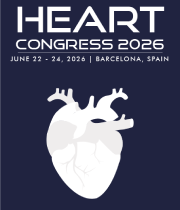Title : Preoperative transthoracic echocardiography to predict postoperative atrial fibrillation following coronary artery bypass grafting
Abstract:
Background: Postoperative atrial fibrillation (POAF) is the most common complication following coronary artery bypass grafting (CABG), which increases the risk of stroke and mortality, prolongs the length of hospital stays, and leads to higher healthcare costs. Structural changes in the atria and ventricles, such as myocardial fibrosis and alterations in mechanical function, constitute one of the crucial preoperative substrates for the development of POAF. However, the potential of transthoracic echocardiography (TTE)—an easily accessible modality for assessing cardiac structural changes—to predict POAF has not been adequately explored. This study aims to elucidate the predictive role of preoperative TTE for POAF after CABG, utilizing data from a large observational cohort.
Methods: A total of 3879 participants undergoing isolated coronary artery bypass grafting, with TTE performed within 7 days before surgery, were consecutively enrolled. The analysis utilized the final preoperative TTE findings. POAF was defined as occurring within 7 days post-surgery. We explored the relationship between POAF and accessible TTE parameters reflecting structural and functional aspects of the atria and ventricles during systolic and diastolic phases.
Results: Of the 3879 participants, 1047 (27.0%) developed POAF. After extensive adjustment for confounding factors, multivariable logistic regression analysis revealed significant differences between patients with and without POAF. Specifically, in terms of left ventricular size and function parameters, a Left ventricle diastolic dysfunction grade (DFG) of ≥1 compared to grade 0 was significantly associated with an increased occurrence of POAF (adjusted Odds Ratio [aOR]: 2.75, 95% Confidence Interval [CI]: 1.53-5.29, p?0.001). Additionally, a significantly larger left atrial anteroposterior dimension (aOR: 1.99, 95%CI: 1.14-3.38, p?0.001) was observed in patients with POAF, while right atrial and ventricular parameters showed no significant difference. Furthermore, the Transthoracic Echocardiographic Index established through logistic regression could significantly enhance the predictive value of clinical features for POAF, as evidenced by improvements in Net Reclassification Improvement (0.17, 95%CI: 0.07–0.32, p?0.001) and Integrated Discrimination Improvement (0.06, 95%CI: 0.01–0.18, p?0.001).
Conclusion: Baseline preoperative left ventricular diastolic dysfunction and left atrial size, as measured by TTE, are independently associated with POAF. As simple, accessible, and cost-effective parameters, focusing on TTE values before CABG surgery aids in predicting POAF and identifying patients who may benefit from preventive treatments.
Audience Take Away
- The independent association of preoperative baseline left ventricular diastolic dysfunction and left atrial size, as measured by TTE, with the risk of POAF following CABG.
- The significance of simple, accessible, and cost-effective preoperative TTE measurements in identifying patients at risk for POAF who might benefit from preventive interventions.
- Medical professionals can integrate preoperative TTE assessments into their evaluation protocols for patients undergoing CABG to identify those at higher risk for POAF. This targeted approach allows for the implementation of preemptive measures, potentially reducing POAF incidence and its associated complications. Additionally, researchers can use the Transthoracic Echocardiographic Index as a tool in further studies to refine risk stratification models for POAF.



